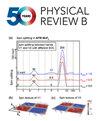利用反铁磁拓扑绝缘体实现高效量子传导
IF 3.7
2区 物理与天体物理
Q1 Physics and Astronomy
引用次数: 0
摘要
在不同的量子系统之间传输量子信息是量子通信和量子计算等各种应用中必不可少的一步。然而,由于多方面的要求,有时甚至是相互冲突的要求,介导不同频率的光子和设计高性能的换能器并非易事。在这项工作中,我们首先讨论了量子换能器设计的一些一般原则,然后提出了固态反铁磁拓扑绝缘体作为特别有效的换能器。首先,反铁磁秩序可以最大限度地减少对附近量子系统的有害磁影响。其次,拓扑绝缘体表现出带型反转,这可以大大增强它们的光学响应。这一特性与强大的自旋轨道耦合和高自旋密度相结合,在磁性拓扑绝缘体中产生了强烈的非线性相互作用,从而大大提高了传导效率。我们以 MnBi2Te4 为例,讨论了基于磁性拓扑材料的量子传导的潜在实验实现。特别是,我们展示了在实验要求不高的情况下,可以实现超过 90% 的量子传导效率,同时传导带宽可以达到千兆赫范围。除了量子传导之外,磁性拓扑绝缘体中的强非线性光子相互作用还能在量子挤压等方面找到多种应用。本文章由计算机程序翻译,如有差异,请以英文原文为准。

Efficient quantum transduction using antiferromagnetic topological insulators
Transduction of quantum information between distinct quantum systems is an essential step in various applications, including quantum communications and quantum computing. However, mediating photons of vastly different frequencies and designing high-performance transducers are highly nontrivial, due to multifaceted and sometimes conflicting requirements. In this work, we first discuss some general principles for quantum transducer design, and then propose solid-state antiferromagnetic topological insulators to serve as particularly effective transducers. First, the antiferromagnetic order can minimize detrimental magnetic influences on nearby quantum systems. Second, topological insulators exhibit band inversion, which can greatly enhance their optical responses. This property, coupled with robust spin-orbit coupling and high spin density, results in strong nonlinear interaction in magnetic topological insulators, thereby substantially improving transduction efficiency. Using as an example, we discuss potential experimental realizations of quantum transduction based on magnetic topological materials. Particularly, we showcase that quantum transduction efficiency exceeding 90% can be achieved with modest experimental requirements, while the transduction bandwidth can reach the gigahertz range. The strong nonlinear photonic interactions in magnetic topological insulators can find diverse applications besides quantum transduction, such as quantum squeezing.
求助全文
通过发布文献求助,成功后即可免费获取论文全文。
去求助
来源期刊

Physical Review B
物理-物理:凝聚态物理
CiteScore
6.70
自引率
32.40%
发文量
0
审稿时长
3.0 months
期刊介绍:
Physical Review B (PRB) is the world’s largest dedicated physics journal, publishing approximately 100 new, high-quality papers each week. The most highly cited journal in condensed matter physics, PRB provides outstanding depth and breadth of coverage, combined with unrivaled context and background for ongoing research by scientists worldwide.
PRB covers the full range of condensed matter, materials physics, and related subfields, including:
-Structure and phase transitions
-Ferroelectrics and multiferroics
-Disordered systems and alloys
-Magnetism
-Superconductivity
-Electronic structure, photonics, and metamaterials
-Semiconductors and mesoscopic systems
-Surfaces, nanoscience, and two-dimensional materials
-Topological states of matter
 求助内容:
求助内容: 应助结果提醒方式:
应助结果提醒方式:


